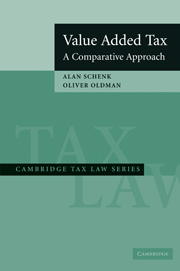Book contents
- Frontmatter
- Contents
- List of Tables, Figures, and Charts
- List of Cases
- Preface to the Revised Edition
- Value Added Tax
- 1 SURVEY OF TAXES ON CONSUMPTION AND INCOME, AND INTRODUCTION TO VALUE ADDED TAX
- 2 FORMS OF CONSUMPTION-BASED TAXES AND ALTERING THE TAX BASE
- 3 VARIETIES OF VAT IN USE
- 4 REGISTRATION, TAXPAYER, AND TAXABLE BUSINESS ACTIVITY
- 5 TAXABLE SUPPLIES OF GOODS AND SERVICES, AND TAX INVOICES
- 6 THE TAX CREDIT MECHANISM
- 7 INTRODUCTION TO CROSS-BORDER ASPECTS OF VAT
- 8 TIMING, TRANSITION AND VALUATION RULES
- 9 ZERO RATING AND EXEMPTIONS AND GOVERNMENT ENTITIES AND NONPROFIT ORGANIZATIONS
- 10 GAMBLING AND FINANCIAL SERVICES (OTHER THAN INSURANCE)
- 11 INSURANCE
- 12 INTERJURISDICTIONAL ASPECTS OF VAT IN FEDERAL COUNTRIES AND COMMON MARKETS
- 13 REAL PROPERTY
- 14 PROPOSALS FOR U.S. TAX ON CONSUMPTION
- APPENDIXES
- Index
9 - ZERO RATING AND EXEMPTIONS AND GOVERNMENT ENTITIES AND NONPROFIT ORGANIZATIONS
Published online by Cambridge University Press: 06 January 2010
- Frontmatter
- Contents
- List of Tables, Figures, and Charts
- List of Cases
- Preface to the Revised Edition
- Value Added Tax
- 1 SURVEY OF TAXES ON CONSUMPTION AND INCOME, AND INTRODUCTION TO VALUE ADDED TAX
- 2 FORMS OF CONSUMPTION-BASED TAXES AND ALTERING THE TAX BASE
- 3 VARIETIES OF VAT IN USE
- 4 REGISTRATION, TAXPAYER, AND TAXABLE BUSINESS ACTIVITY
- 5 TAXABLE SUPPLIES OF GOODS AND SERVICES, AND TAX INVOICES
- 6 THE TAX CREDIT MECHANISM
- 7 INTRODUCTION TO CROSS-BORDER ASPECTS OF VAT
- 8 TIMING, TRANSITION AND VALUATION RULES
- 9 ZERO RATING AND EXEMPTIONS AND GOVERNMENT ENTITIES AND NONPROFIT ORGANIZATIONS
- 10 GAMBLING AND FINANCIAL SERVICES (OTHER THAN INSURANCE)
- 11 INSURANCE
- 12 INTERJURISDICTIONAL ASPECTS OF VAT IN FEDERAL COUNTRIES AND COMMON MARKETS
- 13 REAL PROPERTY
- 14 PROPOSALS FOR U.S. TAX ON CONSUMPTION
- APPENDIXES
- Index
Summary
INTRODUCTION
This chapter covers the use of exemptions and zero rating under a VAT. As discussed in more detail in Chapter 2, the exemption may be an “item” exemption limited to particular supplies or an “entity” exemption applicable to all or most supplies by a particular kind of entity. Zero rating generally is provided for exports of goods (regardless of the nature of the goods exported) and exports of some services. An exemption may be provided for all supplies by a unit of government or nonprofit organization, the exemption may be provided based on the nature of the goods or services supplied, or may be provided for all supplies except those that compete with the private sector.
The next few parts of this chapter cover zero rating, exemptions, and mixed supplies, with attention focused on the complexity resulting from borderline cases involving “item” exemptions or “item” zero rating.
Part VI of this chapter discusses some of the special VAT problems associated with the nonprofit–governmental sectors and proposals to include certain services by these sectors in the VAT base.
ZERO-RATED SALES
IN GENERAL
A zero-rated sale is a taxable sale, subject to tax at a zero rate, and input tax on purchases attributable to that sale is creditable. The sale therefore is basically free of VAT. If a sale at retail is zero rated, the consumer buys the item free of VAT. If the zero rate applied only at an intermediate (such as wholesale) stage, and the retail stage were taxable, the tax not collected at the intermediate stage would be recovered on the retail sale.
- Type
- Chapter
- Information
- Value Added TaxA Comparative Approach, pp. 263 - 300Publisher: Cambridge University PressPrint publication year: 2007



